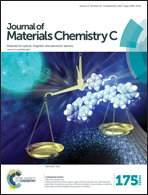Processing a pyridyl-based polymeric additive for improved photovoltaic performance of a wide-bandgap π-conjugated polymer†
Abstract
In this manuscript we introduced a novel conjugated polymeric additive PBTA-Py with benzodithiophene-alt-benzo[1,2,3]triazole as the backbone and polar pyridyl as the terminal group of the side chains. Relative to its polymeric counterpart that consists of the same main chain but a non-polar alkyl side chain, the resulting PBTA-Py exhibits quite comparable absorption and electrochemical properties and significantly improved surface energy. Of particular interest is that, by incorporating a certain amount of PBTA-Py as a polymeric additive into the bulk-heterojunction film of pristine polymer PBTA-BO and PC71BM, the power conversion efficiency was obviously enhanced from 4.96% to 6.48% primarily by virtue of the improved current density. The improved current density can be attributed to the slightly increased hole mobility as revealed by the space charge limited current model. Furthermore X-ray photoelectron spectra confirm the formation of the supramolecular interaction of the nitrogen atom with the electron-deficient PC71BM, leading to increased charge transfer in the bulk-heterojunction layer. These observations, in combination with the formation of more favorable phase separation morphology, demonstrate the great promise of developing polymeric additives for improving the photovoltaic performance of polymer solar cell devices.


 Please wait while we load your content...
Please wait while we load your content...